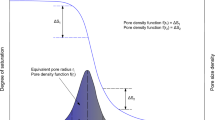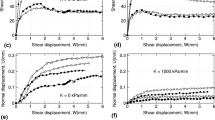Abstract
The present work is focused on the details of a fuzzy set plasticity theory that was used to model the hysteresis loops in the Soil-Water Characteristic Curves (SWCCs). This study first presents an elasto-plastic stress-strain relationships of capillary hysteresis behavior in unsaturated conditions. The linear evolution equation for the elasto-plastic modulus and the membership function in the fuzzy set plasticity theory are introduced. An implicit integration method is then applied to develop the full set of incremental equations. Experimental and literature-cited data were used to evaluate model accuracy. Qualitative predictions of the proposed model show that incorporating soil-water characteristic equation and membership function into the fuzzy set plasticity model opens a full range of possibilities in modeling hysteretic behavior in unsaturated sands.
Similar content being viewed by others
References
Brooks, R. N. and Corey, A. T. (1964). “Hydraulic properties of porous medium.” Hydrology paper No. 3, Civ. Engrg. Dept., Colorado State Univ., Fort Collins, Colo.
Dafalias, Y. F. (1986). “Bounding surface plasticity. I: Mathematical foundation and hypoplasticity.” Journal of Engineering Mechanics, Vol. 112, No. 9, pp. 966–987.
Dafalias, Y. F. and Popov, E. P. (1976). “Plastic internal variables formalism of cyclic plasticity.” Journal of Applied Mechanics, ASME, Vol. 98, No. 4, pp. 645–651.
Fredlund, D. G. and Xing, A. (1994). “Equations for the soil-water characteristic curve.” Canadian Geotechnical Journal, Vol. 31, No. 3, pp. 521–532.
Ge, Y. N. and Sture, S. (2002). “A cyclic plasticity model based on fuzzy set theory.” 15 th ASCE Engineering Mechanics Conference, Columbia University, New York, pp. 1–6.
Gillham, R. W. Klute, A., and Heermann, D. F. (1976). “Hydraulic properties of a porous medium: Measurement and empirical representation.” Soil Science Society of America Journal, Vol. 40, pp. 203–207.
Huang, H. C., Tan, Y. C., Liu, C. W., and Chen, C. H. (2005). “A novel hysteresis model in unsaturated soil.” Hydrological Processes, Vol. 19, pp. 1653–1665.
Klausner, Y. (1991). Fundamentals of Continuum Mechanics of Soils, Springer-Verlag, New York.
Klisinski, M. (1988). “Plasticity theory based on fuzzy sets.” ASCE Journal of Engineering Mechanics, Vol. 114, No. 4, pp. 563–582.
Klisinski, M., Abifadel, N., Runesson, K., and Sture, S. (1991). “Modelling of the behavior of dry sand by an elasto-plastic ‘fuzzy-set’ model.” Computers and Geotechnics, Vol. 11, No. 3, pp. 229–261.
Kosugi, K. (1994). “Three-parameter lognormal distribution model for soil water retention.” Water Resources Research, Vol. 30, No. 4, pp. 891–901.
Li, X. S. (2005). “Modelling of hysteresis response for arbitrary wetting/drying paths.” Computers and Geotechnics, Vol. 32, No. 2, pp. 133–137.
Min, T. K. and Phan, T. H. (2008). “Digital image analysis (DIA) for estimating the degree of saturation of the soil-water characteristic curves (SWCCs).” Journal of the Korean Geotechnical Society, Vol. 24, No. 3, pp. 53–63.
Mualem, Y. (1974). “A conceptual model of hysteresis.” Water Resources Research, Vol. 10, No. 3, pp. 514–520.
Muraleetharan, K. K. and Liu, C. (2006). “Prediction of soil water characteristic curves using an elastoplastic framework.” Proceedings of Sessions of GeoShanghai 2006, Advances in Unsaturated Soil, Seepage, and Environmental Geotechnics (GSP 148), China, ASCE, pp. 86–92.
Pham, Q. H., Fredlund, D. G., and Barbour, S. L. (2003). “A practical hysteresis model for the soil-water characteristic curve for soils with negligible volume change.” Geotechnique, Vol. 53, No. 2, pp. 293–298.
Poulovassilis, A. (1970). “Hysteresis of pore water in granular porous bodies.” Soil Science, Vol. 109, No. 1, pp. 5–12.
Scott, P. S., Farquhar, G. J., and Kouwen, N. (1983). “Hysteresis effects on net infiltration, advances in infiltration.” America Society of Agricultural Engineer, Publ. 11-83, pp. 163–170.
Sharma, R. S. and Mohamed M. H. A. (2003). “An experimental investigation of LNAPL migration in an unsaturated/saturated sand.” Engineering Geology, Vol. 70, No. 3, pp. 305–313.
Sivakumar, M. S. and Voyiadjis, G. Z. (1997). “A simple implicit scheme for stress response computation in plasticity models.” Computational Mechanics, Vol. 20, pp. 520–529.
Talsma, T. (1970). “Hysteresis in two sands and the independent domain model.” Water Resources Research, Vol. 6, No. 3, pp. 964–970.
Topp, G. C. (1969). “Soil-water hysteresis measured in a sandy loam and compared with the hysteretic domain model.” Soil Science Society of America Journal, Vol. 33, pp. 645–651.
Van Genuchten, M. T. (1980). “A closed-form equation for predicting the hydraulic conductivity of unsaturated soils.” Soil Science Society of America Journal, Vol. 44, No. 5, pp. 892–898.
Viaene, P., Vereecken, H., Diels, J., and Feyen, J. (1994). “A statistical analysis of six hysteresis models for the moisture retention characteristic.” Soil Science, Vol. 157, No. 6, pp. 345–355.
Wei, C. and Dewoolkar, M. M. (2006). “A deductive scheme for modeling hysteresis of capillarity.” Proceedings of the Fourth International Conference on Unsaturated Soils, Unsaturated Soils 2006, Part of (GSP 147), Arizona, USA, ASCE, pp. 2420–2431.
Wheeler, S. J., Sharma, R. J., and Buisson, M. S. R. (2003). “Coupling of hydraulic hysteresis and stress-strain behaviour in unsaturated soils.” Géotechnique, Vol. 53, No. 1, pp. 41–54.
Yao, J. T. P. (1980). “Damage assessment of existing structures.” Journal of the Engineering Mechanics Division, ASCE, Vol. 106 (EM4), pp. 785–799.
Zadeh, L. A. (1965). “Fuzzy sets.” Information and Control, Vol. 8, No. 3, pp. 338–353.
Author information
Authors and Affiliations
Corresponding author
Rights and permissions
About this article
Cite this article
Min, TK., Huy, P.T. A Soil-Water hysteresis model for unsaturated sands based on fuzzy set plasticity theory. KSCE J Civ Eng 14, 165–172 (2010). https://doi.org/10.1007/s12205-010-0165-x
Received:
Revised:
Accepted:
Published:
Issue Date:
DOI: https://doi.org/10.1007/s12205-010-0165-x




